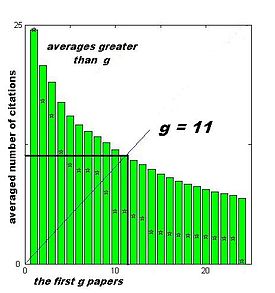|
G-index
The g-index is an author-level metric suggested in 2006 by Leo Egghe.[1] The index is calculated based on the distribution of citations received by a given researcher's publications, such that given a set of articles ranked in decreasing order of the number of citations that they received, the g-index is the unique largest number such that the top g articles received together at least g2 citations. Hence, a g-index of 10 indicates that the top 10 publications of an author have been cited at least 100 times (102), a g-index of 20 indicates that the top 20 publications of an author have been cited 400 times (202). It can be equivalently defined as the largest number n of highly cited articles for which the average number of citations is at least n. This is in fact a rewriting of the definition  as The g-index is an alternative for the older h-index. The h-index does not average the number of citations. Instead, the h-index only requires a minimum of n citations for the least-cited article in the set and thus ignores the citation count of very highly cited publications. Roughly, the effect is that h is the number of works of a quality threshold that rises as h rises; g allows citations from higher-cited works to be used to bolster lower-cited works in meeting this threshold. In effect, the g-index is the maximum reachable value of the h-index if a fixed number of citations can be distributed freely over a fixed number of publications. Therefore, in all cases g is at least h, and is in most cases higher.[1] The g-index often separates authors based on citations to a greater extent compared to the h-index. However, unlike the h-index, the g-index saturates whenever the average number of citations for all publications exceeds the total number of publications; the way it is defined, the g-index is not adapted to this situation. However, if an author with a saturated g-index publishes more, their g-index will increase.
The g-index has been characterized in terms of three natural axioms by Woeginger (2008).[2] The simplest of these three axioms states that by moving citations from weaker articles to stronger articles, one's research index should not decrease. Like the h-index, the g-index is a natural number and thus lacks in discriminatory power. Therefore, Tol (2008) proposed a rational generalisation.[3][clarification needed] Tol also proposed a collective g-index.
References
|


